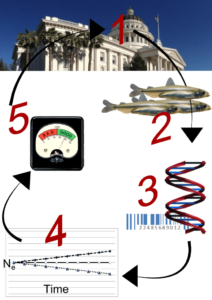
Present monitoring programs were not designed to derive population estimates of Delta smelt. Thus, estimating Delta smelt annual population size (N) has proven challenging due to difficulties in estimating gear efficiencies and sampling in all potentially occupied habitats. Additionally, reliance on an abundance index has hindered the ability to evaluate the role that water exports may play in Delta smelt population dynamics.(1) The ongoing activities of regulators and stakeholders provide (2) information and biological material on which (3) genetic measures can be made. There is an alternative to using an abundance index for assessing Delta Smelt population status. From a conservation and population recovery stand point, the effective population size ( Ne ) is a critical metric to know over time (4), as there are agreed upon thresholds where genetic impact (long term viability) would be minimized (5) – the so called 50/500 rule. Further, the Ne is measurable, which would provide credible and useful information for assessing impacts of water operations to Delta smelt (1).
Information regarding Delta smelt Ne is limited, which was stated as a critical information gap in review of Delta smelt Long-term Operations Opinions Reasonable and Prudent Alternatives. The information that did exist prior to this study showed Ne had approached the threshold where long-term population persistence could be impacted (Ne ~ 1000).

Calculating this alternative population size measure will increase the information content produced from current monitoring activities, adding value without increasing “take”. Additionally, scientifically defensible population size measures could directly inform deliberations about water operation impacts on Delta smelt and population recovery performance measures.
Genetic results were derived by Cramer Fish Sciences, Genidaqs, with data measures independently corroborated by project partner Dr. Mandi Finger. CFS analyzed N=995, N=534, N=678, and N=421 Delta Smelt tissues from year classes 2011, 2012, 2013, and 2014, respectively. These collections represent a majority of Delta Smelt encountered during those years and are archived (as DNA). Observed genetic diversity was high and individual year classes did not differ genetically from each other. The effective population size was estimated for each year class using published methods. At this time, there is no population genetic evidence supporting the hypothesis that Ne of Delta Smelt is below 1000.
The implication of the genetic diversity and Ne information is that a large number of Delta Smelt remain in the San Francisco Estuary system. The current disparity between Delta Smelt abundance indices and Ne is a concern as it may indicate existing monitoring programs will have difficulty adequately representing Delta Smelt abundance, distribution or habitat needs.
The trend in Delta Smelt Ne – as of the 2014 year class – is above the threshold where fitness related (quantitative) genetic diversity is expected to be lost each generation through genetic drift (i.e., Ne > 500). Despite the positive result that the Delta Smelt gene pool is expected to retain quantitative genetic diversity at its present size, the resiliency of Delta Smelt is low because the species occupies a restricted geographic range and largely has an annual reproductive cycle. The Delta Smelt species is recoverable if habitat is provided that is consistent with its life-history requirements.
West Sacramento
(916) 231-1681
3300 Industrial Blvd., Suite 100
West Sacramento, CA 95691
Cramer Fish Sciences
©2024